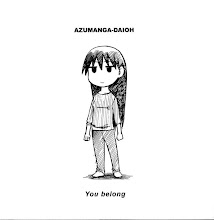The story starts out bouncing between 1969/1970 and the late 1990’s. The most prominent protagonist, Kenji, helps his mother run their family business while taking care of his older sisters' infant daughter, Kanna. His sister arrived home one day, begging for them to take care of the child indefinitely and with no explanation. Kenji, who feels guilty for everything his sister has gone through due to his own selfishness, agrees whole heartedly to care for his niece, much to his mother’s disapproval. A police investigation into the disappearance of a neighborhood family who regularly visits the store brings Kenji face to face with a mysterious symbol that evokes memories he can’t place his finger on. Soon after the sudden and tragic death of a childhood friend he discovers a letter from said friend that contains the same symbol and asks him if he remembers it from their childhood. During the funeral and the class reunion that follows he begins to question his other friends about the symbol. As they stew over it they begin retelling their childhood adventures in the summers of 1969 and 1970 as the youth revolution was taking place and a group of adolescent boys played in an abandoned field, planning future roles as saviors of mankind.
As Kenji tries to dredge through he and his friends memories a mysterious cult is spreading. The leader of the cult is an enigmatic figure known only as ‘Friend’ who wears the symbol from Kenji’s childhood as a mask. Kenji digs deeper into the mystery of his past and discovers that the cult of Friend is more related to him than he expected. He finds disturbing evidence that the missing family and his friends’ death are linked to the cult. His friend’s collective memories help them to rediscover a buried time capsule from their childhood that confirms the symbol and alarming events that are unfolding in the world which could bring mankind to the brink of destruction. It is now up to Kenji and his childhood compatriots to come to the worlds rescue, just as they pretended in childhood games in their grass fort 30 years previously.
I started reading the manga a few years ago and enjoyed it, but for unremembered reasons stopped reading it only to return to it once again recently due to my renewing interest in it’s author. Naoki Urasawa is fast becoming one of my favorite mangaka due to his well detailed art and excellent story telling. He is truly a master of his art and continues to produce riveting and engaging stories. He has distinct character designs which are simplistic in form but present a world full of normal looking people as opposed to biijin or standard manga fare. You can tell that someone is Asian or European in his character designs. Artistically, his best work is in backgrounds and mechanical designs, of which he devotes much of his detail too. Urasawa seems to belong to the same school as Katsuhiro Otomo (Akira, Steam Boy and Domu) as both artists have similar character designs and attention to background and mechanical details.
While 20th Century Boys is an incredibly well done and engaging series, it is relatively long. It is uncertain to me whether Urasawa had the rough outline of how the series would go from the start or if he continued it for as long as he thought would work. For a story that has a definite ending to it he was able to extend it to the length of an open ended series like Naruto or Lone Wolf and Cub. At times the length can contribute to some fatigue as you are just wanted to see a resolution to the story. The end of the story does also seem abrupt. The climax was long and well done but the final events fall flat just a little bit and don’t exactly explain everything, feeling as if the ending was rushed. This for the most part is alleviated by the short follow up series 21st Century Boys. At times the large character base can also become confusion, especially with people being referred to with their actual names and their nicknames, which might partially be on purpose. This comes into play most notably in trying to figure out the identity of ‘Friend’.
Aside from its faults this is an excellent series, something that can transcend the otaku barrier of most manga. The series doesn’t pander to any manga otaku standards or stereotypes but does pay homage to classic era comics, such as Tetsujin 28. The story is realistic, the characters, while larger than life, are ordinary and the suspense and mystery are of a trans-cultural style. The series has been made into a trilogy of live action films as well, which are to be released on disc in America 







No comments:
Post a Comment